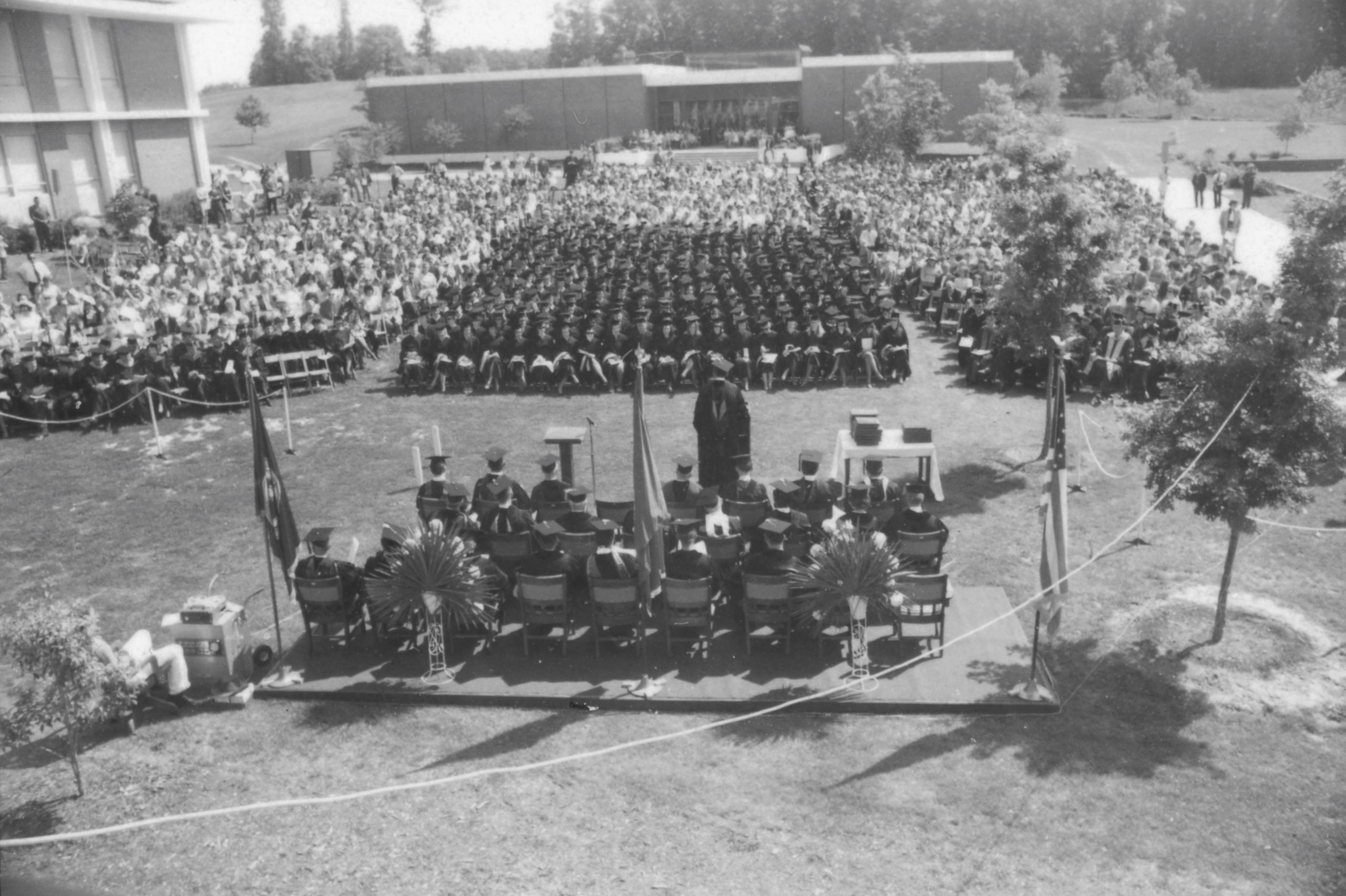
Mason students and administrators watch Governor A. Linwood Holton, Jr. sign the bill that creates George Mason University, April 7, 1972. George Mason University Broadside and Gunston Ledger, #R0128. April 9, 1972. Note that the individual who captioned the photo mistakenly dated the ceremony “April 4”.
This post is part of a four-part series detailing the history of George Mason University from the student perspective. Our initial post, Before We Became George Mason University: Our First Campus at Bailey’s Crossroads, can be read here: https://vault217.gmu.edu/?p=10138 and Establishing our Identity: George Mason’s Fairfax Campus, can be read here: https://vault217.gmu.edu/?p=10152
On Friday April 7, 1972, representatives of George Mason College, led by Chancellor Lorin A. Thompson, met with Virginia Governor A. Linwood Holton, Jr. at Richmond to participate in the Governor’s signing into law the bill separating George Mason College from the University of Virginia and creating George Mason University. During the brief afternoon ceremony Mason administrators, Student Body President, James Corrigan, Student Senator, Anne O’ Grady, and student government members, Tim Watson and Marion Tisdale were photographed side by side with the Governor as he signed the bill, known as H-210.
Mason began down the road to independence in the mid-1960s. Beginning in 1965 the area’s growth, highlighted by a dramatic increase in the population of college-aged men and women, pointed out the need for an independent and accessible four-year institution of higher learning in the area. By 1969 local governments had purchased 421 acres of land on behalf of George Mason, increasing its campus size by nearly 400% and giving the potential regional university needed room to grow. Studies done in the late 1960s suggested Mason might be serving 15,000 students by 1985.

A news clipping from an unidentified source shows George Mason College Chancellor, Lorin A. Thompson pointing to a map showing parcels of land surrounding George Mason’s Fairfax Campus in 1967. By 1969 Mason had acquired 421 additional acres of land for future growth as a university. University Relations news clippings and press releases records R0004 Box 2, Folder 1.
The University of Virginia planned to make its branch colleges independent for years but kept these plans quiet during the fall of 1971. By late January 1972 the secret was out. A bill to separate Mason from the University of Virginia (H-210) had been was introduced in the Virginia Legislature on January 28. On February 7 Broadside declared that the separation of George Mason from the University was “imminent” after learning that Virginia’s Board of Visitors recommended the separation. The Board cited the college’s accomplishments, current and expected growth, financial support, and backing from the State Council of Higher Education.
After the passage of H-210, graduating students were given the option of having “George Mason College of the University of Virginia” or “George Mason University” printed on their diploma. About 40% of the Class of 1972 chose “George Mason University”.

Commencement ceremony for the George Mason University Class of 1972, June 10, 1972. Members of this graduating class were given the option of having “The University of Virginia” or “George Mason University” printed on their diplomas. George Mason University photograph collection, #R0120, Box 2. This photo was taken from the roof of the South Building (now known as Krug Hall).
Mason’s rapid leap into Virginia’s group of regional universities, pointed up the need for more academic and student-focused buildings. Administrators wanted more classroom space. Students wanted a student union and campus housing. A number of high-profile building projects began in 1972. The Physical Education Building (today known as the RAC), the University Union (today’s SUB I), Robinson Hall (replaced by Horizon Hall in 2021) and the Fenwick Library Tower would be built in the next 5 years. Still, some students voiced their concern in letters to Broadside, and to their representatives in Student Government that there were no plans for residence halls. Also concerning to some in the Mason community, as well as others in northern Virginia, was the lack of diversity among the students, faculty, and staff at George Mason.
The Special Collections Research Center has mounted an exhibit entitled: “We Are Mason: A Student History” celebrating George Mason’s 50th Anniversary and the role students have played in its history. Please visit https://scrc.gmu.edu/wearemason.php for more information.
Follow SCRC on Social Media and look out for future posts on our Facebook, Instagram, and Twitter accounts. To search the collections held at Special Collections Research Center, go to our website and browse the finding aids by subject or title. You may also e-mail us at speccoll@gmu.edu or call 703-993-2220 if you would like to schedule an appointment, request materials, or if you have questions.

